Cleaner air means safer workspaces. Compliance with air quality regulations is critical to maintaining a productive, legally sound operation. A baghouse dust collector helps industrial facilities achieve both by efficiently removing harmful dust from production processes.
This guide explains what a baghouse dust collector is, how it works, its key components, maintenance best practices, and regulatory considerations.
What Is a Baghouse Dust Collector?
A baghouse dust collector is an industrial air filtration system that captures and removes airborne dust and particulate matter from manufacturing and processing environments.
It uses fabric filter bags to separate dust from the air, releasing clean air back into the facility or the environment.
Baghouse systems are commonly used in industries like cement, metalworking, woodworking, mining, and chemical processing — basically anywhere dust is generated as part of operations. Their high efficiency and durability make them ideal for facilities aiming to meet strict emissions standards.
Compared to other filtration systems, baghouses stand out for their ability to handle large volumes of dust and operate reliably under challenging conditions.
This capacity makes them a preferred solution for facilities facing high dust loads or demanding applications.
How Does a Baghouse Dust Collector Work?
At its core, a baghouse dust collector filters dirty air through a series of fabric bags. Here’s how the process works:
- Dust-laden air enters the collector through an inlet, either by suction or positive pressure.
- Particles are captured on the outside of the filter bags as the air passes through the fabric.
- Clean air exits the collector and is either recirculated or released outdoors.
- Collected dust falls into a hopper below the filters, ready for disposal.
The filter bags are periodically cleaned using pulse-jet bursts of compressed air or a shaker mechanism to keep the system running efficiently. This process dislodges the dust buildup so it drops into the hopper.
Once collected in the hopper, the dust is typically funneled into sealed drums or conveyors for safe handling and disposal, ensuring it doesn’t re-enter the airstream or contaminate other areas in the facility.
Key Components of a Baghouse System
A baghouse dust collector includes several critical parts that work together. Each plays a key role in capturing dust, maintaining airflow, and keeping the system running smoothly:
- Filter Bags: Fabric filters that trap dust particles.
- Bag Cages: Support structures inside each filter bag to prevent collapse.
- Hopper: A bin beneath the filters that collects dislodged dust.
- Cleaning System: Mechanisms (pulse-jet, reverse air, or shaker) to clean the filter bags.
- Control Panel: Automated controls for cleaning cycles, pressure monitoring, and maintenance alerts.
Filter bags come in different materials depending on application needs, such as polyester for general use, PTFE-coated fabrics for high-moisture environments, and aramid for high-temperature resistance.
Each media type offers specific benefits for durability, chemical resistance, and filtration efficiency.
Why Choose a Baghouse Dust Collector?
Industrial facilities choose baghouse dust collectors for their proven benefits. Some standout features of baghouses include:
- High filtration efficiency — capturing fine particulates and meeting stringent air quality standards.
- Durability and long lifespan with proper maintenance.
- Lower operating costs over time due to reusable filter bags and fewer replacements.
- Compliance with OSHA and EPA regulations for workplace air quality.
Baghouses are a cost-effective solution for managing high dust loads in demanding environments.
Maintenance Best Practices for Baghouse Dust Collectors
Routine maintenance keeps your baghouse operating efficiently and extends its lifespan. Key practices include:
- Inspect filter bags regularly for wear, tears, or clogging.
- Replace filters proactively based on pressure drop readings or scheduled intervals.
- Monitor pressure differentials to detect issues early.
- Check for leaks or damage in seals, hoppers, and ductwork.
- Verify cleaning system performance to ensure filters are regenerating properly.
A proactive maintenance plan reduces unexpected downtime and helps maintain compliance, keeping your facility dust-free and running smoothly.
Regulatory Considerations for Baghouse Operations
Baghouse dust collectors help facilities meet environmental regulations for air emissions. Facilities must comply with federal and local standards, including those set by the EPA and OSHA.
The EPA’s Best Practices for Compliant Bag Leak Detection Systems outlines key strategies to ensure continuous monitoring and compliance, such as:
- Regular calibration of bag leak detection systems to maintain accuracy
- Documenting and retaining performance data for audits
- Installing alarms to notify operators of filter failures
- Positioning sensors in optimal locations for reliable monitoring
- Establishing corrective action procedures when leaks are detected
Together, these practices build a strong foundation for compliance and operational reliability, ensuring your baghouse system meets regulatory requirements while maintaining peak performance.
Choosing the Right Baghouse Dust Collector for Your Facility
Selecting the ideal baghouse system depends on several factors. It’s essential to consider both the type of dust and the operational environment to ensure the system performs reliably and remains compliant over time:
- Dust characteristics: particle size, abrasiveness, and moisture content.
- Airflow volume: cubic feet per minute (CFM) required.
- Operating conditions: temperature, humidity, and corrosive agents.
- Industry-specific standards: compliance requirements for your sector.
Work with a trusted supplier who can assess your facility’s needs and recommend a tailored solution.
Baghouse America brings decades of industry expertise, offering personalized recommendations that align with your dust collection challenges and regulatory requirements.
Final Thoughts: Is a Baghouse Dust Collector Right for You?
A baghouse dust collector offers a reliable, efficient solution for managing industrial dust and protecting air quality. With proper design, maintenance, and compliance practices, it can deliver long-term performance and regulatory peace of mind.
Contact Baghouse America today for expert guidance on choosing the right dust collection system for your operation.

